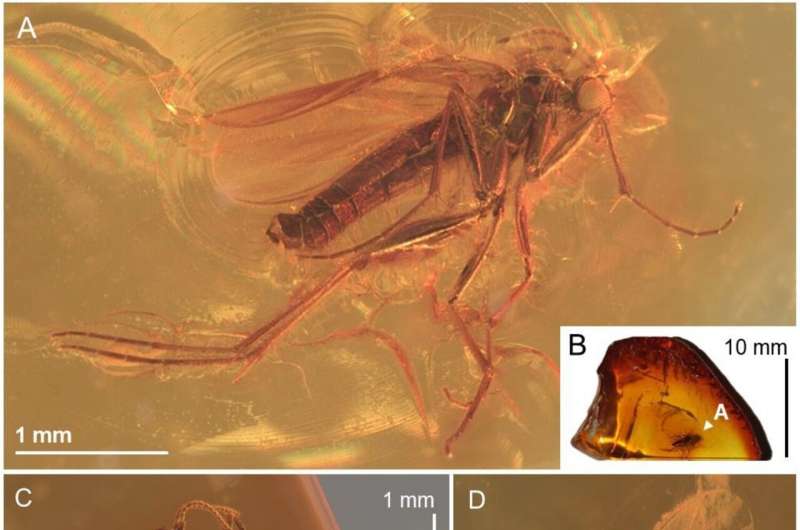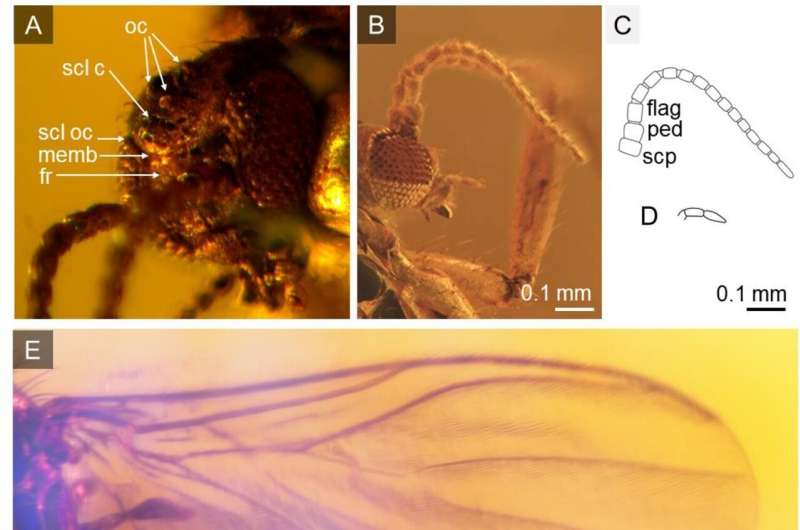This article has been reviewed according to Science X's editorial process and policies. Editors have highlighted the following attributes while ensuring the content's credibility:
fact-checked
peer-reviewed publication
trusted source
proofread
Fungus gnat entombed in a 40-million-year-old piece of amber is a rare gem

A Danish amber collector's find upon a wild North Sea shore in the 1960's has proved to be of great and surprising significance. After having thoroughly examined the roughly 40-million-year-old piece of amber, University of Copenhagen researchers have discovered it to contain the first fossil of a predatory fungus gnat belonging to a rare genus. The research contributes new knowledge about the distribution of the gnat species and about biodiversity across space and time.
The research is published in the journal Scientific Reports.
Are you fed up with the summertime onslaught of fruit flies, gnats, mosquitoes and other tiny winged insects? If so, be happy that you weren't around 40 million years ago. Back then, Europe's climate was warmer and more humid, which provided favorable conditions for gnats, among other things.
One of these gnats, which met its end after being trapped in a lump of pine resin, has given researchers from the Natural History Museum of Denmark the opportunity to add a new prehistoric gnat species to its family of insects. This first fossil of a rare and never before studied species of gnat, Robsonomyia henningseni, was found in a piece of Baltic amber along Denmark's North Sea coast in the 1960's.
For decades, the piece had been tucked away in the museum's 70,000-piece amber collection. Recently, it was retrieved from the drawers and subjected to a thorough examination by a team of Polish entomologists. The insect specialists were able to identify the gnat as an extinct species from a rare genus of predatory gnats. Today, living species of the genus are only found in Hokkaido, Japan and California.
"This is the first time that anyone has found a fossil gnat of this genus, which were only thought to live in Japan and North America. The finding demonstrates that this type of gnat was also widespread in Europe during past climates and gives us new knowledge about the gnat's distribution on Earth," explains Alicja Pełczyńska, a Ph.D. student at the University of Łódź and University of Copenhagen, who conducted the description of the gnat.
The researchers believe that the ancient gnat is a kind of "missing link" that connects its two rare and still living relatives in Japan and the United States. The overland distance between the living species has puzzled researchers, but the new fossil demonstrates that the species' path may have traversed the European continent.
"Until now, the distribution of this genus of gnat has been strange, with many thousands of kilometers between species. Therefore, it makes sense to have found it in Europe, which is approximately halfway between Japan and North America," says Pełczyńska.

C.V. Henningsen—Danish amber collector and gnat namesake
To learn more about the amber-entombed gnat, the researchers began by polishing the ocean and sun-matted amber piece until it was glossy and transparent.
Once transparent, they used an advanced camera and spectrometer to take a chemical fingerprint of the amber. This confirmed that the piece is from Baltic amber. Thereafter, they examined the fossil and determined the species of insect. This part of the process took place by closely studying the males' genitalia, where identifying characteristics often vary.
"Insects mate end to end, which places certain demands on their genitalia. The male has appendages, or forceps, next to the actual penis, which it uses to grasp the female gnat with while mating. We used the shape of these forceps to identify it," explains Lars Vilhelmsen, an associate professor and curator at the Natural History Museum of Denmark.
Based on the analysis, the researchers estimate that the gnat buzzed about in the enormous pine forests of what we now know as Scandinavia some 35–40 million years ago. Here, the gnat became trapped in a lump of resin upon a tree, which rivers, ocean currents and glaciers of the last ice age carried to the North Sea.
"An amber collector by the name of C.V. Henningsen found the piece of amber on the western coast of Jutland back in the 1960's. Henningsen sold the piece, along with the rest of his collection, to the Natural History Museum of Denmark. Since the gnat species had never been described before, we named it after him, and it is now known as Robsonomyia henningseni," says Vilhelmsen.
Unlike in Jurassic Park, there's no DNA
Amber is an outstanding natural time capsule for scientists. With its protective lamination, it preserves ancient insects and plant remains and lets us learn about what Earth looked like up to 230 million years ago. But if released from its amber encasing, the insect will disappear.
According to Vilhelmsen, there is no blood or DNA to suck out of the gnats so as to reanimate them in any way, as is done in the Jurassic Park films.
"Virtually all of the organic material in the gnat has long since decomposed, making it a hollow shell. If one tries to remove it from the amber, it crumbles. As such, the best thing we can do is to study it inside the amber. Insects trapped in amber can be studied almost as precisely as their living relatives using microCT scans," explains Vilhelmsen.
The new discovery of the gnat fossil equips researchers with new knowledge about the general migrations of gnats across Earth and contributes to the larger picture of biodiversity through time.
More information: Alicja Pełczyńska et al, Eocene amber provides the first fossil record and bridges distributional gap in the rare genus Robsonomyia (Diptera: Keroplatidae), Scientific Reports (2024). DOI: 10.1038/s41598-024-59448-y
Journal information: Scientific Reports
Provided by University of Copenhagen





















